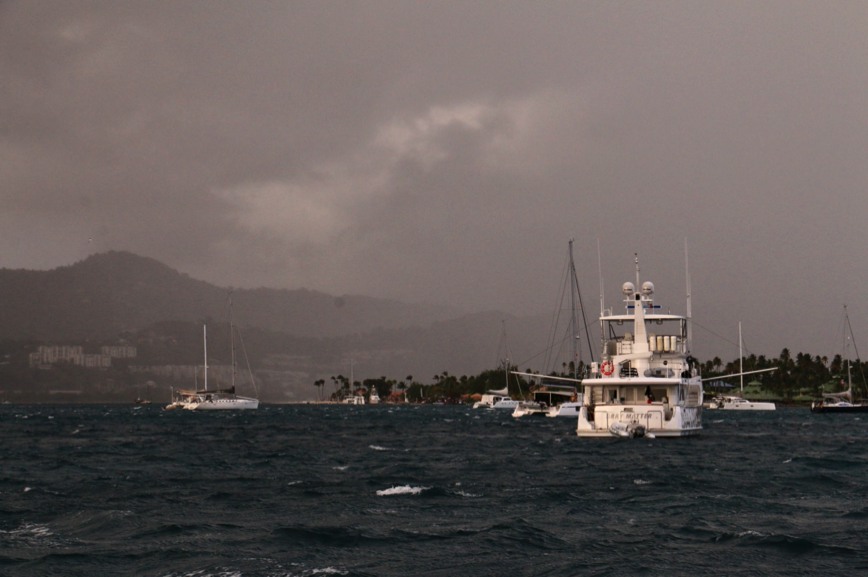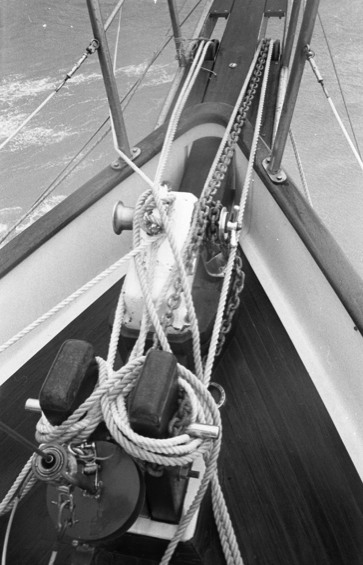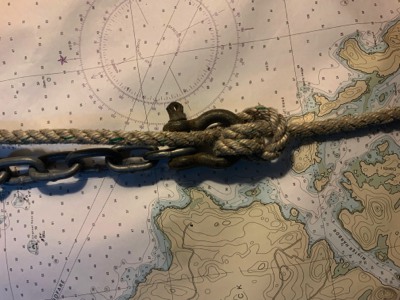Storm Anchoring
in The Caribbean
Story and Photos by David Lyman,
with the help of a few fellow sailors
Originally published in Caribbean Compass, July 2020.
THE height of hurricane season is upon us, and Don Street, Larry Tyler and I have been kicking around what gear and techniques we’ve used to survive hurricanes at anchor in the islands. This is far from a definitive report, and much has been published on the topic previously
in Compass and elsewhere, but we felt that a reminder or two might be helpful. Besides, this was a good excuse for the three of us to swap stories — and you’ll notice we often don’t agree.
Anchoring techniques in a hurricane
If you would be at anchor in the event of a big blow, where — in which harbor, cove or roadstead — would you want to be? What’s the bottom like there? What’s the storm’s track?
I’d want to position the anchors so that the boat faces the worst of the blow. What techniques would you use to get the anchors down and firmly wedded to the bottom? What do you consider adequate scope, ten to one? Do you dive to see how the ground-tackle fares? What do you use for chafe guard?
What else to you do to ready your boat for a hurricane? Do you plan to stay onboard and ride out the storm? Do you have an exit plan should all fail and you and the boat wind up on the beach?
Let’s get to some answers.
Anchors and Anchoring
Our debate rages on: CQR, Bruce, Danforth, Herreshoff Bronze, the Bulwagga, Fortress, Delta, Rocna. Navy, Yachtsman, Fisherman, a large stone... have I forgotten anything? It’s like arguing over golf clubs, but then none of us plays golf.
In this article I share my first-hand Caribbean storm-anchoring experience. Don and Larry offer some food for thought, too.
I’ve always had a Danforth or two aboard my four boats. This funny-looking anchor was invented in 1939 by Henry Danforth and was used to great effect during the D-Day landing on Normandy Beach. The anchor, with its wide triangular flukes, was dropped astern as the LSTs approached the beach; it set quickly in the sand, and held. After off-loading troops the LSTs kedged themselves back into deeper water. The Danforth works well in all types of bottom, except sea grass.
The Danforth is light, light enough to be loaded into the dinghy and run out and dropped. It sets quickly, if you have at least 30 feet of chain attached. I’ve also had one secured aft on the push-pit, as a stern kedge. The Fortress, a more modern version of the Danforth, is very light and also sets quickly — great to load into the dinghy and run out as a second anchor. While some may prefer it, I consider it too light to be a storm anchor.
On Searcher, my Bowman 57 ketch, my working anchor was a 66-pound Bruce, the largest they make, on all chain, stowed on a bow roller. Next to it was a 43-pound Danforth on 30 feet of chain and 300 feet of five-eighths-inch nylon rode, ready to run out quickly as a backup, should my working anchor drag.
My storm anchor was an 80-pound Luke, with chain and rode stowed below under a bunk. Paul Luke, whose yard is just down the coast from my home in Maine, modified the Fisherman anchor’s traditional configuration so it can be taken apart into three pieces and thus more easily stowed. It can be put back together on deck in three minutes. (Don Street disagrees with my choice of a storm anchor: “The Luke anchor is highly regarded in Maine but I feel useless in the Caribbean. The fisherman-style anchors will only dig into sand if the flukes are sharp. We dragged the Luke so often we abandoned using it.”)
I rode out three hurricanes on Afaran, my Lord Nelson 41: Hurricane Emily, in Bermuda 1987; Hurricane Hugo, in Coral Bay, St. John, USVI, in 1989; and Hurricane Luís, in Maho Bay, St. John, USVI, in 1995. In all cases, I deployed the working anchor — a 45-pound CQR on all chain — and a 90-pound Fisherman, set in a Y off the bow.
The Fisherman sets fast, due to its design and sharp arrowhead flukes. It buries itself in most any bottom, and if there’s a wind shift, will reposition itself or quickly reset. The Fisherman, or Yachtsman, design has been around since Columbus sailed, so why it is not seen on today’s yachts? It doesn’t look nice, it’s dangerous to stow on deck and is a pain to deal with.
Don says, “On Iolaire through the years we used the Wilcox Crittenden (a copy of the three-piece Herreshoff, but not in three pieces) as her standard anchor. This always held her until it started blowing 25 gusting to 30, when we set a second anchor. I once bought a three-piece Luke, but found it absolutely useless in Caribbean. The three-piece Australian version we also found useless, but a 150-pound copy of the Herreshoff was a life insurance policy. I’d also bet on a stainless steel cast Danforth from WWII. High tensile Danforths are easily stowed by making the cross arms removable. Other good storm anchor include Northill, CQR, Fortress, and Bruce.”
Larry, who has been sailing The Dove in the Caribbean for 30 years, has the following to add: “I have only ever used a CQR on this boat and on my last boat. The CQR has always protected me, even down at the bottom of the world in the Beagle Channel with lots of kelp forests, and in Antarctica, as well as during numerous typhoons in the Philippines. I had a Fisherman anchor on my last boat and it might have been nice to use one down in Patagonia with so much kelp in the anchorages. Now, I see a lot of new spade-type anchors on the bows of sailing boats and different articles written about tests done on them. They are similar to the CQR but with no swivel and a roll bar. I have no idea if they are any better.
The Seabed
Actually, staying hooked to the bottom in a blow is less about the anchor than the bottom itself, the seabed. Is it soft mud, sand, gravel, kelp, sea grass, ledge, coral rubble, or a mixture? No anchor is going to set if the seabed is hard coral or smooth ledge. Aside from being an environmental taboo, anchoring amid coral heads risks your anchor getting lodged or the rode chafing. Anchor in an unknown harbor and you wind up snagging a cable, a sunken derelict, or an abandoned anchor.
Paper charts provide an idea of bottom composition along with the depth marking. In the old days, a man went forward into the chains and cast a lead. This ten- pound lump of lead had a hollow notch in the bottom, filled with grease to pick up a sample of what was on the bottom. Haul it up and you had a good idea of what lay beneath you. Active Captain on Navionics may give some idea of bottom conditions in particular anchorages. Better yet, go for a swim before selecting your final anchoring spot to see what’s down there. If there’s deep sand, no obstacles, and not much slope, great. And of course get back in water after dropping the hook to make sure it’s properly set.
Your boat’s foredeck
Many modern yachts are meant to be tied to a dock. Few have a strong point forward to which a thick mooring line or multiple anchor lines can be secured. Deck cleats are often too small to secure a hawser, with no backing plate under the deck. Chocks and fairleads often require an anchor line to make a sharp turn, increasing friction and chafe. Important: The windlass
must not be used for securing storm gear. The windlass is for retrieving ground tackle, not as a strong point. (I made this mistake once, and bent the windlass shaft so it now wobbles.)
A Samson post is a strong wooden or metal post rooted in the keel and passing up through the deck where the top eight or 12 inches provide a strong attachment point for the anchor cable, or for mooring and towing warps. Secure anchor rodes to a Samson post forward, or, if you want to be able to adjust them from the cockpit, lead them aft to your primary winches. Afaran had a stout Samson post just aft of the windlass (see photo), ideal for securing more than a few lines. With a tugboat hitch, or a series of bends, I could release each line to make adjustments. When I acquired Searcher I had a Samson post installed just off center, forward of the windless — and used it.
My Chafe Solution
If the aim is to eliminate chafe, simply don’t run your nylon lines over the side. Instead, attach a short length of chain from the strong point on deck, through the chocks or over the bow roller, and a few feet outboard, where it can be shackled to the nylon snubber or
anchor rode.
Snubbing line: Make up a 30-foot length of nylon as a snubbing line. Splice thimbles at each end. One end is shackled to the outboard end of the short chain, the other end shackled to a chain hook that’s clipped to the anchor chain. No chance of chafe now, and you can still haul in the chain and attach the snubber in a different location.
Nylon anchor rode: If you use a nylon anchor rode, use another short length of chain over the side, deploy the anchor, run out the scope, and attach a shackle at an appropriate point in the rode by taking a two turns around the bendy end of a shackle, loop the bitter end around the standing line and bring it back through the shackle (see photo). Attach the shackle to the end of the chain, run the lazy end aboard and secure. The strain is now transferred to the chain. The modified anchor hitch I’ve described will not jam and can be unwound when pulled on deck and the tension released. This gives you the ability to haul in the rode, disconnect the rode from shackle and the chain, adjust and re-deploy.
Don, in one of his articles, says if you have a bowsprit with a strut fixed to a plate at the waterline, that would be a good spot to shackle a chain-to-rode purchase.
A word about nylon anchor rode.
Keep your storm rodes below, out of the sun, until needed. UV damages nylon, resulting in a loss in strength. Use the best line you can afford, as it will have more internal lubricant to lessen internal friction while stretching.
Staying aboard in a hurricane
I wrote about my experiences staying aboard in Hurricane Hugo in 1989, in Compass last summer (see the May, June, and July 2020 issues.
I lost Afaran in 1995 when Hurricane Marilyn came through the USVI. The boat was moored in Great Cruz Bay, St. John, and I was not aboard. Less than two weeks earlier, I’d ridden out Hurricane Luís in Maho Bay and put her back on her mooring. Had I been aboard in Great Cruz Bay when Marilyn came through I would not have survived. But then I would not have been in Great Cruz Bay; I would have moved Afaran to Maho Bay again, where the chances were far better of survival.
Whether or not to stay aboard is a question that only you can answer. Would I stay aboard again, at my age? Depends on my boat, its location, the intensity of the blow, the shape of the harbor, the bottom, and the number and condition of the boats around me.
And research suggests that in the future, there may not necessarily be more hurricanes, but they will likely be more intense.
There’s one more consideration.
Insurance coverage.
Are the boat and I covered for total loss from a named storm? If so, there’s less reason to remain aboard. Insurance companies advise owners: prepare as best you can and go ashore. Make sure your broker has a copy of your written “Named Storm Preparation Plan.”
One more thing more. What’s your exit plan should the boat be blown ashore? Where will you be? Blown on to a beach, you might be able to step ashore and the boat might be easily re-floated. What if the lee shore is a rocky cliff or high seawall?
If you haven’t done so already, it’s high time to review your strategy, dust off your storm plan, inspect your ground tackle, and review your anchoring techniques.
Resources
• Practical Sailor magazine has conducted numerous tests on the holding power of various anchors, and their independent reports are online and in print. For example, see www.practical-sailor.com/sails-rigging- deckgear/anchor-resetting-tests.
• Daria and Alex Blackwell’s book Happy Hooking — The Art of Anchoring is available at Amazon.com and at their website, www.coastalboating.net.
• Don Street’s “Anchors... and Why They Don’t Work,” was published in the January 2015 issue of Compass; see page 36 at www.caribbeancompass.com/ online/january15compass_online.pdf.
Read more on hurricanes in Don’s website, www.street-iolaire.com.
• Fatty Goodlander’s book Creative Anchoring: Everything About Anchors and Anchoring is available from his website, http://fattygoodlander.com.
• Chris Doyle wrote about making anchor upgrades in the July 2020 issue of Compass; see page 12 at www.caribbeancompass.com/online/ july20compass_online.pdf.
• I wrote about my experiences being aboard during a hurricane in the May, June, and July 2020 issues of Compass; see www.caribbeancompass.com/ back-issues



